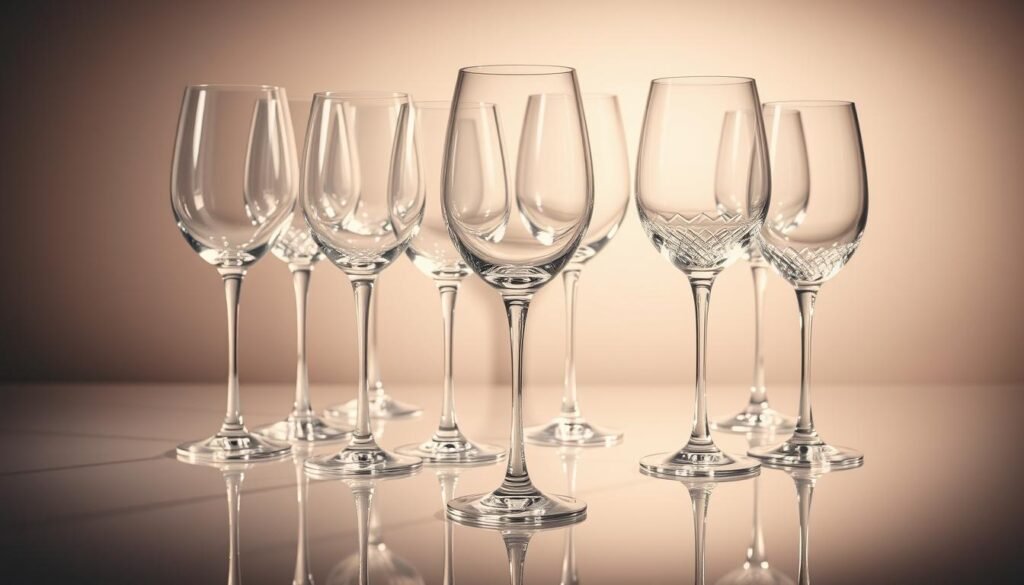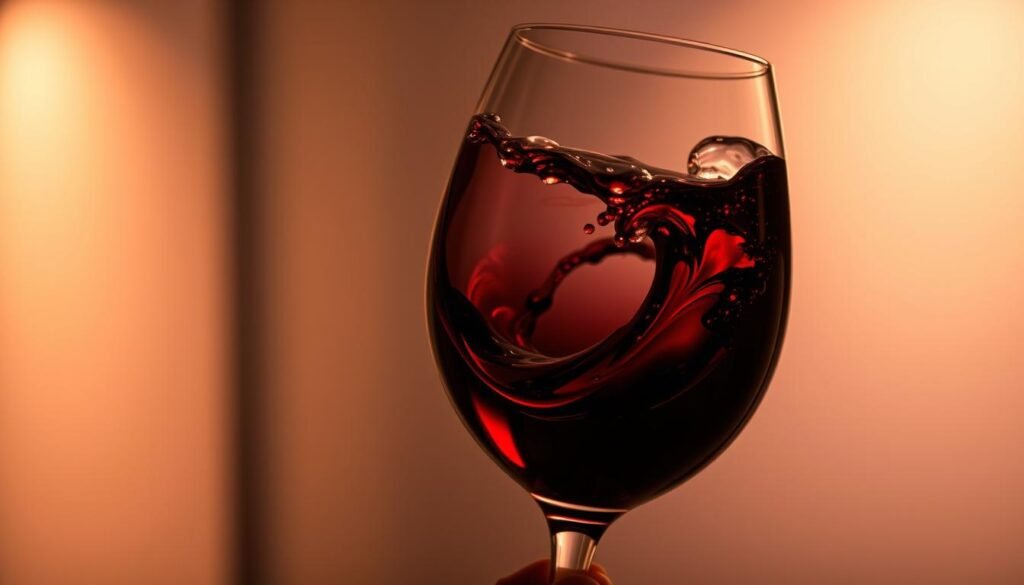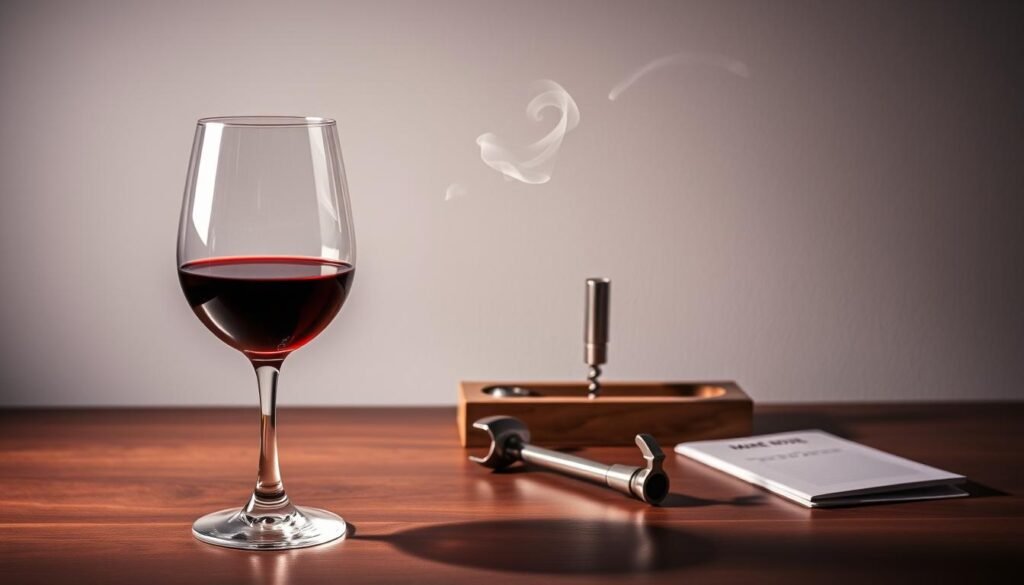I’m excited to share my love for luxury wine with women who enjoy the finer things. Becoming a sommelier is more than just knowing about wine. It’s about developing a sense of elegance and finesse. Wine tasting is a mix of luxury, great food, and company, making it a joy for the senses.
As we explore wine tasting, we’ll learn how sommeliers enjoy each glass. We’ll look at the wine’s appearance, smell, taste, and finish. Whether you’re new to wine or already love it, knowing the Five S’s is key to enjoying wine like a pro.
Key Takeaways
- Wine appreciation is a sensory experience that combines luxury wine, cuisine, and company
- Becoming a sommelier requires knowledge, sophistication, and refinement
- The Five S’s of wine tasting are essential for a truly sophisticated wine appreciation experience
- Luxury wine is a key component of wine appreciation, offering a range of complex flavors and aromas
- Wine tasting is a skill that can be developed with practice and patience, allowing you to fully appreciate the nuances of luxury wine
- A sommelier’s expertise is rooted in a deep understanding of wine, including its origins, production methods, and pairing possibilities
- Wine appreciation is a journey, not a destination, and one that offers countless opportunities for discovery and exploration
The Art of Wine Appreciation in Modern Luxury Living
Exploring wine, I’ve learned it’s an art needing knowledge, confidence, and a sense of adventure. In today’s luxury world, knowing about wine shows sophistication. The wine industry is growing, thanks to more women sommeliers, making it more diverse and welcoming. To grow our confidence, we must grasp the value of wine and food pairing and get good at wine tasting techniques.
In the world of luxury lifestyle, wine appreciation is more than just drinking. It’s about enjoying the flavors, trying new types, and learning about each bottle’s creation. Whether you’re an expert or new to wine, learning to appreciate it can make dining better and open up new cultural experiences.
- Discovering different wine regions and their special traits
- Understanding various wine styles and their pairing options
- Practicing wine tasting techniques to sharpen our taste
By diving into these areas, we can learn more about wine and its place in luxury living. This will help us appreciate wine even more.
What is Known as the Five S’s of Wine Tasting?
Exploring wine tasting, I’m drawn to the Five S’s. These steps are key for sommeliers to understand wine. Sight, Swirl, Sniff, Sip, and Savor are a journey through senses. They help us enjoy wine’s flavors and smells.
Mastering the Five S’s makes wine tasting better. It lets us understand wine’s complex tastes and smells.
The Five S’s teach us to slow down and enjoy wine. We start by looking at the wine’s Sight. This shows us its color, clarity, and thickness.
Swirling the wine releases its aromas and flavors. Then, we can smell the wine’s bouquet. Finally, tasting and savoring let us enjoy its flavors and textures.
Following the Five S’s unlocks wine’s full potential. It helps us find new tastes and smells.
Some key aspects of the Five S’s include:
- Observing the wine’s color and clarity
- Swirling the wine to release aromas and flavors
- Appreciating the wine’s bouquet
- Experiencing the wine’s flavors and textures
- Savoring the wine’s finish
Setting the Perfect Scene for Wine Tasting
When I get ready for a wine tasting, I think about the atmosphere. The wine tasting environment really affects how I see the wine. Every little thing, like the wine glassware and temperature control, counts.
Essential Elements for a Perfect Tasting
I make sure to have the right wine glassware for each wine. For example, a Chardonnay needs a wide bowl glass to show off its rich flavors. The wine tasting environment should be quiet and free from distractions. This lets me enjoy the wine’s details fully.

Creating the Ideal Atmosphere
Along with the right wine glassware and wine tasting environment, keeping the wine at the right temperature is key. Serving wine at the perfect temperature brings out its best flavors and smells. For instance, a Pinot Noir tastes better when it’s cooler, keeping its delicate taste intact.
Mastering the First S: Sight
Exploring the world of wine, I’ve learned how crucial sight is. The first S, sight, lets me see the wine color, wine clarity, and wine viscosity. This helps me understand the wine’s age, grape type, and quality.
Wine’s look tells a lot about its character. For example, a Cabernet Sauvignon’s deep reds and a Sauvignon Blanc’s crisp whites hint at the grape and oxidation level. The wine clarity also shows the filtration and any sediment.
When I look at a wine, I think about these things:
- Wine color: The color and intensity tell me about the grape and age.
- Wine clarity: How clear and bright the wine is shows the filtration and sediment.
- Wine viscosity: The wine’s thickness and flow tell me about sugar and alcohol levels.
Learning to see wine well makes my tasting better. Whether it’s a rich red or a zesty white, sight is key. It starts a great wine experience.
The Second S: Swirling with Style
Exploring wine has taught me the importance of swirling. This technique releases a wine’s aromas and flavors. By swirling correctly, I can see the wine’s legs and texture, which tells me about its body and aging potential. Swirling is key in tasting wine, as it lets the wine breathe and show off its complex tastes and smells.

Proper Swirling Technique
To swirl wine right, hold the glass by the stem. Then, rotate it in a circle. This lets the wine flow smoothly and releases its aromas and flavors. It also lets you see the wine’s legs and how thick it is.
Understanding Wine Legs
Wine legs, or tears, are the streaks that flow down the glass after swirling. Their thickness and speed tell us about the wine’s viscosity and aging potential. Thicker, slower legs mean a fuller-bodied wine, while thinner, faster legs suggest a lighter wine.
What Swirling Reveals About Your Wine
Swirling your wine lets you understand its qualities better. It shows the wine’s aromas, flavors, and texture. Whether you’re new to wine or experienced, mastering swirling is crucial for a better tasting experience.
Exploring the Third S: Sniff
As I explore the world of wine, I’m drawn to its complex aromas and scents. The third S, Sniff, is key to understanding a wine’s character. It’s an experience that can be both thrilling and challenging.
By smelling the wine, we can pick up on various aromas and scents. From the fruity hints of a Merlot to the floral notes of a Riesling, each wine has its own unique scent.
The wine aroma is like a symphony of scents, with each note important to the overall harmony. Swirling the wine lets the wine bouquet reveal its secrets. It releases a mix of fruit, floral, and earthy notes.
The intensity of the wine scent can vary. It can be strong and dominant or soft and subtle. This depends on the wine’s type and age.
Some common wine aroma characteristics include:
- Fruity notes, such as citrus, berries, or stone fruits
- Floral notes, such as rose, lavender, or honeysuckle
- Earthy notes, such as mushroom, leather, or tobacco
Exploring wine is a journey, not a destination. The third S, Sniff, invites us to slow down and appreciate the wine’s aroma, bouquet, and scent.
The Fourth S: Sip with Sophistication
As I lift my glass, I know the moment of truth is here. It’s time to taste the wine’s wine flavor and wine structure. The right way to sip is key to enjoying the wine’s complexity. I take a small sip and let it sit in my mouth.
This lets me feel the wine’s main flavors and textures. From a Chardonnay’s crisp acidity to a Pinot Noir’s smooth tannins, it’s all about the experience.
To truly enjoy the wine structure, I look at the balance of acidity, tannins, and sweetness. A balanced wine feels smooth and refreshing. As I sip, I notice how the flavors change and stay with me.

When judging the wine flavor and wine structure, consider these points:
- Acidity: It’s the crisp, refreshing quality that cuts through richness.
- Tannins: They give a drying feel that balances sweetness and adds depth.
- Body: This is the wine’s weight and texture, from light and crisp to full and rich.
By focusing on these aspects and sipping correctly, I can fully enjoy the wine’s subtleties. Whether it’s a rich Cabernet Sauvignon or a crisp Sauvignon Blanc, the goal is to appreciate the wine flavor and wine structure. And to savor the wine finish that stays with me.
Discovering the Fifth S: Savor
The final step in wine tasting is the most rewarding – savoring the wine’s finish and aftertaste. By fully appreciating the wine’s lingering flavors and textures, we discover a new level of complexity. Whether it’s the dry, toasted notes of a robust Cabernet Sauvignon or the delicate, fruity finish of a crisp Pinot Grigio, this final S invites us to slow down and truly connect with the wine.
Savoring a wine also lets us explore how it pairs with different foods. The wine’s characteristics and the dish’s flavors can create a harmonious symphony on the palate. By mindfully savoring each sip, we can find the perfect pairings that elevate both the wine and the meal.
As we conclude our journey through the Five S’s of wine tasting, remember that the true art lies in taking the time to appreciate each step. By honing our senses and connecting with the wine, we unlock a world of flavor, history, and cultural richness. So raise your glass, take a deep breath, and savor the experience – for it is in those fleeting moments that we find true wine enlightenment.

